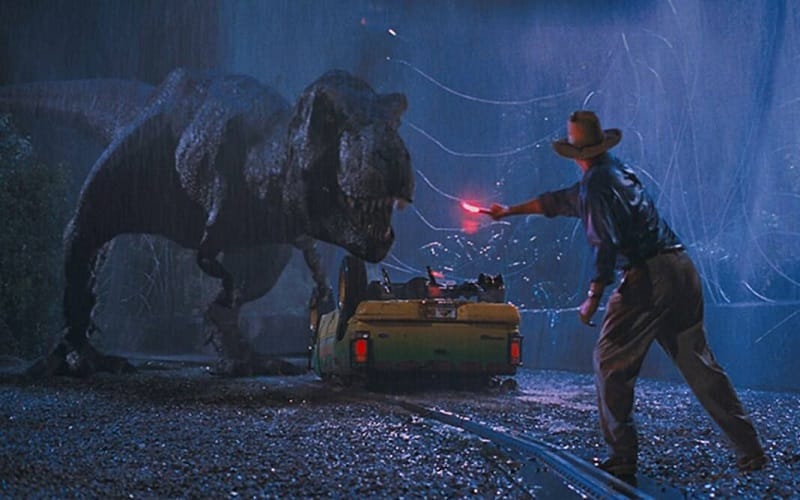Nov. 20, 2020

Feature
After 30 Years, Jurassic Park Can’t Be Replicated
What is it about this genre-defining technothriller that makes it both ultramodern and classic at the same time?
Tehra Peace
“A day is like a whole life. You start out doing one thing, but end up doing something else, plan to run an errand, but never get there… And at the end of your life, your whole existence has that same haphazard quality, too. Your whole life has the same shape as a single day.”
Friday marks the 30th anniversary of Michael Crichton’s groundbreaking technothriller, Jurassic Park. Published on Nov. 20, 1990, Jurassic Park set the platinum standard for science-based thrillers. Decades later, it remains in a class of its own in genre fiction and has spawned a series of blockbuster films that are still being made today. But what was it that made the book so remarkable?
I first got my hands on it in 1996, at the age of 13, and it was nothing like anything I had ever read before. Eighth-grade girls must have been far from Crichton’s target market. But by the time my paperback had made its way through five or six of my friends, it was so well-read that the binding had fallen apart. The book was the gateway to a new world of reading: The Lost World, Sphere, The Andromeda Strain.
Its runaway success didn’t necessarily make sense. The story is part biotech, part philosophy, part late-80s IT system architecture. It is inadvisably complex. There is no charismatic protagonist to help navigate the story. (The closest contender, Alan Grant, shows up on page 31 after dozens of named characters are introduced. He continues to share the narrative with several other strong point-of-view characters.) It routinely breaks into academic lecture. It is rushed in some places and meandering in others.
And somehow, it’s a masterpiece.
Writers have been trying to capture the magic of Jurassic Park’s storytelling ever since. In honor of the book’s 30-year anniversary, I re-read it to see if I could help explain why it makes such a lasting impression.
“Biotechnology is going to transform every aspect of human life: our medical care, our food, our health, our entertainment, our very bodies.”
- Crichton opens with a lecture on the potential and risks of the biotech revolution. To be honest, it’s a ballsy move. But it’s captivating.
- The main conflict is stated on the second page of the introduction: “…nearly every scientist in genetics research is also engaged in the commerce of biotechnology.” No beating around the bush.
- The introduction is only four pages, but it’s absolutely packed with expertise. It’s like what James Rollins told us earlier this month: when you write, make sure you nail the details.
- How did I forget about Dr. Roberta Carter? She’s an emergency medicine doctor from Chicago. Could this be an early “ER” prototype?
- Crichton continues with the expert details as he describes the injury of the InGen worker who was mauled by a velociraptor. Side note: Bobbie Carter should have been in the movie.
- Hey look, it’s the first iteration! Sorry, but no other book will ever top the section breaks like those fractal curve drawings.
- Now we’re with the rich family who’s picnicking on the remote beach. The mom, Ellen, wants plastic surgery . . . and she’s 30? The parents are letting their 8-year-old run down the beach alone. Maybe the times have changed, but that might not be a good idea.
- Our first dino! It’s a compy, and it goes right to the girl’s face. Poor Tina, you crazy animal lover.
- Alice Levin coming in hot with “Teenysaurus.” I’d love to see a buddy procedural with her and Dr. Carter.
- Alan Grant, finally. I forgot that he had a beard. Sam Neil would have rocked that look.
- Wow, Ellie Sattler is a babe. Is she with Grant in the book? She’s 24 and he’s 40, not that I’m complaining. And there she goes, chugging a beer.
- The EPA guy and Grant are talking about how the Hammond Foundation is funding dinosaur digs and buying genetic engineering equipment. Yet they still can’t figure out what he’s doing on his private island in Costa Rica?
- Gennaro meets Sattler and remarks, “You’re a woman.” Her reply? “These things happen.” What an icon.
“In the information society, nobody thinks. We expected to banish paper, but we actually banished thought.”
- Ian Malcolm, the legend. And wow, he’s hitting on Sattler right away. I think Crichton was trying to make Malcolm annoying, but Jeff Goldblum spoiled that with his charm.
- Now we’re getting into chaos theory. I might have understood this better at 13. Or at least I thought I did.
- Aw, they see dinos for the first time. If I ever get to see dinosaurs, this is how I want it to happen.
- Grant says everybody knew dinosaur cloning was coming, but not so soon. So, it’s 30 years later. Where are my dinosaurs?
- Tim sounds way too sophisticated for an 11-year-old. Then again, I remember relating to him at 13. So maybe Crichton was right in giving the kids a little extra maturity.
- Henry Wu is explaining why they made so many compys: to scavenge the brontosaurus stool because the bacteria to decompose it no longer exists. This is such an awesome example of how Crichton came up with his own hypothetical problems and solutions.
- Oh right, the lysine dependency. I just love how beautifully Crichton could set up an airtight plan for the dinosaurs not being able to breed or survive on their own, only to completely destroy it.
- Malcom deduces that the velociraptors have killed humans before by the way they “hunted” him, Grant, Sattler, and Tim. (It’s a behavior they must have learned.) I’m remembering now why I loved book Malcolm. He makes actual observations instead of just talking about theory.
- Interesting that Wu is trying to convince Hammond to modify the dinosaurs. This is what his character ends up doing in the fourth movie. The difference is that, here, Wu is encouraging Hammond to make them more domesticated—slower and easier to manage. It’s the opposite of what Wu does in the movies.
- They discover that the dinosaurs are breeding. Arnold’s system is set to check for only the expected 238 animals. When Malcolm tells him to change that to 239, it finds an extra compy. How brilliant is that twist?
- Hammond, Arnold, and Wu are watching the numbers climb as the computer counts all the dinos in the park, while frantically arguing about why it’s happening.
- Raptors are on the supply boat! But the phones and radios are down, so Grant can’t warn them. Here’s where that classic thriller countdown starts.
- Nedry has taken down the perimeter power. The Land Cruisers are in the T-Rex paddock. Here we go!
- Ed Regis, the PR guy, leaves the kids alone in the car. I think he’s going to regret that.
- Did the T-rex just eat Lex?
- No, the T-rex took out Malcolm! Grant just realized that it can’t see him if he doesn’t move.
- And there goes Nedry, blinded and disemboweled by a dilophosaur. What a way to go.
- Regis is eaten by the juvenile T-rex as the kids and Grant watch silently from the forest. This book is metal.
- Muldoon and Gennaro are searching the wreckage and find Malcolm. And Regis’s leg.
- Tim’s relentless questioning confirms that Grant and Sattler are not a thing. In fact, she’s engaged to someone else. If I’m keeping track, that means there are zero romantic entanglements in Jurassic Park the book.
- The Malcolm Effect, the point at which a whole system could suddenly collapse. If that hasn’t already happened, it’s about to.
- After sleeping all night in a maintenance shed, Grant and the kids are being chased down the river by a T-rex.
- Now they’re in the creepy aviary. At least they only got Lex’s glove. Her Darryl Strawberry special.
- OK, now they’ve gone over a waterfall and survived the T-rex again? I definitely don’t remember that.
- Well, crap. They just realized they’ve been running on auxiliary power, and now everything has turned off again. Plus, the fences haven’t been electrified this entire time. Sheesh.
- Gennaro is breaking bad, running around with Muldoon and hunting velociraptors. Spielberg really neutered him in the movie.
- Malcolm on morphine is a whole mood. His rantings might be my favorite part of the book.
- Sattler’s going to distract the raptors so Grant can get into the maintenance shed and turn on the power. Meanwhile, the raptors are chewing through the metal bars over the skylight. Fun fact, the vet is the father of Sarah Harding from The Lost World.
- The raptors got Wu. Nice knowing you.
“You decide you’ll control nature, and from that moment on you’re in deep trouble, because you can’t do it. . . . Your powers are much less than your dreams of reason would have you believe.”
- Tim gets the power on just in time to save Malcolm, Sattler, and Muldoon from the raptors. They also call back the boat just before it reaches the shore of the mainland. That was close.
- Grant and Muldoon decide they need to find the raptor nests. Why? I’m honestly not sure.
- Hammond is eaten alive by compys. Ew.
- The raptors want to migrate. That’s why they want off the island. Clever girls.
- Grant, Sattler, the kids, Muldoon, and Gennaro are in the helicopter. RIP Malcolm. At least until you’re resurrected for the next book.
- Everyone watches as the dinosaurs are bombed back to extinction.
- Ooh, but there are hints that the velociraptors might have reached the mainland. They’re eating lysine-rich crops.
- Also, cliffhanger: Grant and Sattler aren’t going to be released by the Costa Rican government anytime soon.
So, what did I learn from re-reading Jurassic Park? I think it’s that remarkable stories happen when authors lean into their passions. Crichton didn’t write about dinosaurs because they’re larger than life. He wrote about them because he was obsessed. He didn’t try too hard to manufacture a story. He let himself—through Malcom, mostly—rant and lecture about things he cared about. And it worked. Thirty years later, Jurassic Park is truly unmatched, unreplicated, and unforgettable.
About the Author
Tehra Peace
A marketing copywriter by day and an up-too-late reader by night, she loves getting caught in a good, twisty plot. In her free time, she writes her own (yet-to-be-published) mystery novels.
Tehra is the Features Editor at Mystery and Suspense Magazine.

